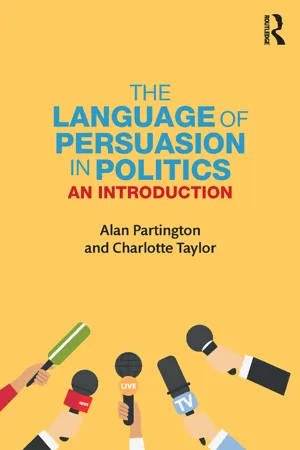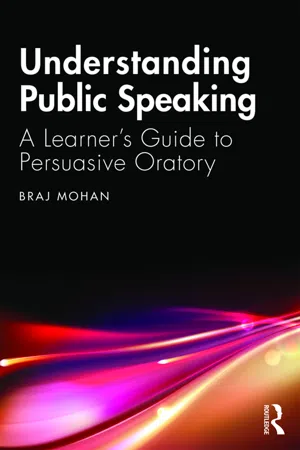Induction Rhetoric
Induction rhetoric refers to a persuasive technique that aims to influence an audience by using examples and specific instances to draw general conclusions. It involves presenting specific cases to support a broader claim, often appealing to the audience's emotions and experiences. This rhetorical strategy is commonly used in persuasive writing and speech to build a compelling argument based on specific instances.
5 Key excerpts on "Induction Rhetoric"
- eBook - ePub
- Kirsten Malmkjaer, Kirsten Malmkjaer(Authors)
- 2009(Publication Date)
- Routledge(Publisher)
...All well-planned, well-executed and well-analysed linguistic research provides fascinating insights into the myriad ways that individuals use language. Surely, such an important aspect of human communication, indeed some claim that human ability to use language is one of the defining characteristics of humanity itself, deserves to be researched as carefully and as accurately as possible so that there is evidence to support the claims being made. A. B. Suggestions for further reading Wray, A and Bloomer, A (2006) Projects in Linguistics, 2nd edn, London: Routledge. Rhetoric Rhetoric is an ambiguous term. Among other things, it refers to an ancient discipline with an uneven, complex history, an activity connected to the pragmatic dimension of language, a body of precepts about that activity, a teaching tradition dedicated to the cultivation of citizens who have the capacity to speak and write persuasively, and a mode of critical analysis designed to help citizens resist symbolic techniques of repression. Confronted with this ambiguity, rhetoricians have not been able to settle themselves within tidy disciplinary borders but have manoeuvred around a set of permanently unsettled basic questions: is rhetoric a global symbolic activity that pertains to all discourse and that invites inquiry into the means by which discourse achieves its purposes? Or should it be conceived as a more limited activity that operates within the domain of civic affairs and that implicitly or explicitly connects with a set of ethical and political values? Is rhetoric an ‘art’ (i.e...
- eBook - ePub
Critical Thinking
A Concise Guide
- Tracy Bowell, Robert Cowan, Gary Kemp(Authors)
- 2019(Publication Date)
- Routledge(Publisher)
...The aim of our discussion of rhetorical ploys is to introduce readers to some common devices in which rhetoric is deployed by speakers and writers to persuade us to do, believe, or desire things and to explain how these ploys are effective at influencing us. It is not our intention to provide an exhaustive account of the uses of rhetoric. Finally, we provide a brief discussion of buzzwords, jargon, spin and gas-lighting, all of which are used rhetorically to influence our opinions, decisions and choices by pushing the buttons of our sensitivities and to camouflage the true meaning of what someone is saying or writing. Increasingly, we also see them employed in what’s known as dog whistle politics, whereby political messages that may be offensive to a general audience are encoded in apparently innocent language but able to be picked up by their target audience. Such messages often express racist and misogynistic sentiments. Again, our aim here is to introduce these phenomena to readers and to create an awareness of how they work and of the importance of avoiding them in our own attempts to persuade. • Linguistic phenomena As we’ve seen, once we’ve determined that a text or a speech contains an attempt to persuade by argument, the remainder of argument-reconstruction is largely a matter of interpreting the speech or text as accurately as possible. Here we are trying to work out what the speaker or writer intends readers or listeners to understand, and consequently do or believe, on hearing or reading their words. Some of the ways in which we tend to use ordinary language make this task more difficult because they obscure speakers’ and writers’ intended meanings and thus make it hard to tell which proposition their sentences are supposed to express. So to be effective as critical thinkers, we need to be aware of the ways in which language can work to hide writers’ and speakers’ meanings and should become adept at spotting potentially problematic sentences...
- eBook - ePub
The Language of Persuasion in Politics
An Introduction
- Alan Partington, Charlotte Taylor(Authors)
- 2017(Publication Date)
- Routledge(Publisher)
...And persuasion is of itself neither good nor bad, neither beneficial nor harmful, but in practice it can be both or neither. Rhetoric is language at work, and language at play: It is what persuades and cajoles, inspires and bamboozles, thrills and misdirects. It causes criminals to be convicted and then frees those criminals on appeal. It causes governments to rise and fall […] and perfectly sensible adults to march with steady purpose towards machine guns. (Leith 2012: 6) 1.2 Persuasion and rhetoric in a democratic society In an absolutist or totalitarian regime (from the Roman Empire to Nazi Germany or the Soviet Union), those in power rule by using the twin weapons of coercion and the manipulation of information (for a current example of the latter, browse the North Korean regime’s official Twitter feed @uriminzok_engl). In a pluralistic democracy, instead, the principal use of language in politics is for persuasion in debate. In fact, the art of political persuasion in this sense was born with the first democracy in ancient Greece. The Greeks developed what they termed the art of rhetoric, which is none other than the skill of persuasion. More formal rhetoric was generally felt to have three main fields of application: for politics (agora, that is ‘public space’), for law (forensic) and for speeches of public praise or blame (epideictic). As Charteris-Black (2013: 3) points out, the most frequent adjective which modifies rhetoric in the British National Corpus is political, followed by public. Thus, rhetoric is still seen as central to both senses of political discourse. Aristotle also identified three basic appeals of rhetoric. The first, ethos, is the attempt to establish the credentials to justify why you should be listened to, perhaps because you are interesting and witty or, if a politician, strong, honest and experienced...
- eBook - ePub
Understanding Public Speaking
A Learner's Guide to Persuasive Oratory
- Braj Mohan(Author)
- 2019(Publication Date)
- Routledge India(Publisher)
...Therefore, a recommendation for trainee orators is that they sometimes need to engage in socio-drama of dress and decorum according to the popular culture of the audience society; however, they should not look insincere in doing so. In the present book, I’ll not explain socio-drama and other extra-linguistic factors in any more detail as my main focus is on the linguistic and paralinguistic strategies of persuasion as used in persuasive oratory. Persuasive use of language has been an area of interest for scholars since the time of Ancient Greece and Rome. Rhetoric was an essential part of public education. Scholars like Aristotle, Cicero and Quintilian enriched the art of persuasive oratory by identifying and devising some powerful rhetorical strategies, some of which are summarized in the next chapter. The area of persuasive use of language attracts scholars as forcefully today as it did in the past. Persuasive use of language has been an area of interest among scholars of Pragmatics and Social Psychology as these social sciences share some common ground in the study of persuasion. A lot of research on the persuasive use of language has been conducted in the field of Social Psychology. The psychologists tried to understand how people are persuaded to change their decision in favour of a persuader, and formulated certain models of persuasion. The scholars of Pragmatics also made a meaningful contribution to understanding the nature of persuasive and polite language. In this connection, special mention can be made of Brown and Levinson’s Theory of Politeness, Austin’s Speech Act Theory and Grice’s Cooperative Principle. As Marie-Odile Taillard (2015) suggests, there are two goals in persuasive communication: to be understood and to be believed. The pragmatists are interested in investigating the first goal, while the second goal has been an area of investigation for social psychologists...
- eBook - ePub
- Janet Maybin, Neil Mercer, Ann Hewings, Janet Maybin, Neil Mercer, Ann Hewings(Authors)
- 2020(Publication Date)
- Routledge(Publisher)
...The confirmation is the basic argument for the points that the speaker wishes to prove. The refutation, as the term suggests, involves undermining an opponent’s argument. The conclusion should consist of three parts: summing up the speaker’s argument, inciting indignation against the opponent, and ensuring that the speaker or the speaker’s client is perceived sympathetically. These simple recommendations formed the basis for courses in rhetoric for many centuries. The main points we can draw from Cicero’s analysis are: that rhetorical speech designed for use in specific contexts (such as the law courts of ancient Greece) may have some common, distinctive structural features that it may be possible to identify some specific, effective techniques for convincing and persuading. Modern political rhetoric When analysing examples of rhetoric it is important to put the data into context. One key question involves the extent to which the example being analysed is pre-planned. Another question involves whether or not the data is spoken, or written, or written to be spoken - and many political speeches then also appear in an officially released format which does not necessarily coincide exactly with what was said. Below, you will be reading political rhetoric designed to be read and scripts of speeches that may be tidied up versions of what was actually said, together with short extracts of speeches transcribed from television recordings. ACTIVITY 2.3 Allow about 5 minutes As I write, it is the middle of a general election campaign in the UK. Read the extracts below from a Labour Party election leaflet from a candidate who has been the local Member of Parliament for some years. She is a member of the Labour Party which has been the government for the past eight years. The Conservative Party has been the main party of opposition. Underline the pronouns and possessives (e.g. you/your/we/our/they/them)...




